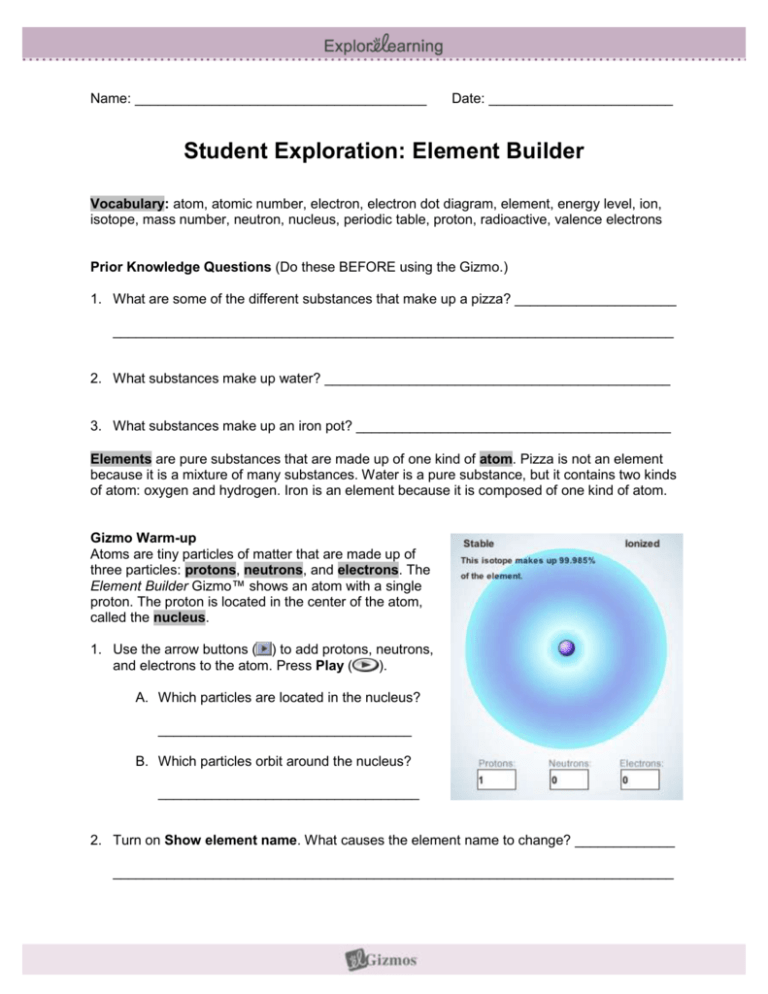Student Exploration Sheet: Growing Plants
advertisement

Name: ______________________________________ Date: ________________________ Student Exploration: Element Builder Vocabulary: atom, atomic number, electron, electron dot diagram, element, energy level, ion, isotope, mass number, neutron, nucleus, periodic table, proton, radioactive, valence electrons Prior Knowledge Questions (Do these BEFORE using the Gizmo.) 1. What are some of the different substances that make up a pizza? _____________________ _________________________________________________________________________ 2. What substances make up water? _____________________________________________ 3. What substances make up an iron pot? _________________________________________ Elements are pure substances that are made up of one kind of atom. Pizza is not an element because it is a mixture of many substances. Water is a pure substance, but it contains two kinds of atom: oxygen and hydrogen. Iron is an element because it is composed of one kind of atom. Gizmo Warm-up Atoms are tiny particles of matter that are made up of three particles: protons, neutrons, and electrons. The Element Builder Gizmo™ shows an atom with a single proton. The proton is located in the center of the atom, called the nucleus. 1. Use the arrow buttons ( ) to add protons, neutrons, and electrons to the atom. Press Play ( ). A. Which particles are located in the nucleus? _________________________________ B. Which particles orbit around the nucleus? __________________________________ 2. Turn on Show element name. What causes the element name to change? _____________ _________________________________________________________________________ Activity A: Subatomic particles Get the Gizmo ready: Use the arrows to create an atom with two protons, two neutrons, and two electrons. Turn on Show element name. Question: What are the properties of protons, neutrons, and electrons? 1. Observe: Turn on Show element symbol and Element notation. Three numbers surround the element symbol: the mass number (A), electrical charge (no number is displayed if the atom is neutral), and the atomic number (Z). 2. Investigate: Watch how the numbers change as you add or remove particles. A. Which number is equal to the number of protons in the atom? __________________ B. How can you calculate the number of neutrons (N) in an atom? _________________ ___________________________________________________________________ C. Which particle (proton, neutron, or electron) has a positive charge? ______________ Negative charge? ______________ No charge at all? ______________ 3. Analyze: An isotope is an alternative form of an element. Each isotope of an element has the same number of protons, but a different number of neutrons. The isotope is represented by the atomic symbol and mass number, such as He-4. Some isotopes are stable, while others are radioactive, which means the atoms decay over time and emit radiation. A. What are the stable isotopes of carbon? ___________________________________ B. What are the stable isotopes of nitrogen? __________________________________ C. List two radioactive isotopes of oxygen: ___________________________________ 4. Practice: Use the Gizmo to answer the following questions. A. How many electrons are in a neutral atom of lithium? ______ B. How many neutrons are in an atom of Mg-25? ______ C. What is the mass number of an atom with 5 protons and 7 neutrons? ______ D. When at atom is charged, it is called an ion. How many electrons are in O2-? ______ E. How many electrons are in Mg2+? ______ Activity B: Electron arrangements Get the Gizmo ready: Create a neutral hydrogen atom (1 proton, 0 neutrons, 1 electron). Question: How are electrons arranged around the nucleus of an atom? 1. Observe: Add electrons to the atom until you have used all the available electrons. What do you notice? _______________________________________________________________ _________________________________________________________________________ 2. Analyze: Electrons are arranged in orbits called energy levels. The Gizmo shows all of the first two energy levels but only part of the third energy level. A. How many electrons can fit in the first energy level? ___________ B. How many electrons can fit in the second energy level? ___________ C. How many electrons fit in the part of the third energy level shown? ___________ 3. Observe: Click Reset ( ). The electrons in the outermost orbit, called valence electrons, help to create chemical bonds. Create a lithium atom (3 protons, 4 neutrons, 3 electrons). How many valence electrons are in a neutral lithium atom? ___________ 4. Extend your thinking: Many chemical properties are determined by the number of valence electrons. Elements with the same number of valence electrons will have similar properties. Which element has similar properties to lithium? _________ Beryllium? _________ Explain: __________________________________________________________________ Get the Gizmo ready: Extension: The periodic table Create a neutral hydrogen atom. If you have access to a periodic table, open it now. (Not required.) Question: The 117 or so known elements are arranged in the periodic table. Why does the periodic table have the shape it has? 1. Form a hypothesis: Look at the first three rows of the periodic table below. Why do you think the elements are arranged the way that they are? ___________________ _________________________________________________________________________ 2. Draw diagrams: How many valence electrons are in each of the following elements. Use the Gizmo to help you do this. H He Li Be B C N O F Ne Na Mg Al Si P S Cl Ar 3. Analyze: What do the elements in each column of the periodic table have in common? _________________________________________________________________________ _________________________________________________________________________ 4. Draw conclusions: How is the periodic table organized? ____________________________ _________________________________________________________________________ _________________________________________________________________________ _________________________________________________________________________









